The ultimate online course playbook
What can you learn about nailing your messaging, launch strategy, and list-building for your first digital course—from a digital marketing OG who has built a $100M business?
We have three words for you: Amy. (Freaking.) Porterfield.
Amy is an entrepreneurial powerhouse, online marketing expert, podcast host, and New York Times bestselling author that slowly but surely took the world of digital courses by storm when she started her business 15 years ago.
Now, she’s helped more than 80,000 students grow their email lists, create digital courses, and build online businesses they love. But she didn’t start out magically knowing exactly what to do.
“When I left my corporate job, I didn't know what I was going to sell, but I knew I wanted control over when, where, and how I wanted to work,” says Amy.
Whether you’ve already launched a course and need refinement, or are considering creating a digital course for your business from scratch, this just could be the playbook that makes your wild dreams a reality. ✨
So, let's short-cut your way to prominence and profit by tapping into the wisdom and best practices gained from Amy’s 15 years of launching million-dollar digital courses.
The goal
“You don't need a bunch of offers in order to make an amazing living online. You only need one digital course to be wildly profitable.” - Amy Porterfield
According to Amy, digital courses are the gateway to becoming known as an expert in your niche, growing a profitable and engaged community, and creating long-term recurring revenue for your business.
Sounds pretty magical, right?
Unsurprisingly, all the authors of our past playbooks have digital courses as part of their repertoires, too: Codie Sanchez, Ali Abdaal, and Maya Elious.
Amy’s courses (both evergreen and live launch format) have earned her millions upon millions of dollars in recurring revenue, as well as notoriety in the online marketing space.
But the key to her success… is kind of boring. 😅
Amy preaches focus and commitment to one topic—to the point where if anyone so much as whispers your keyword—whether it’s “online course” or “square foot gardening” or “relationship coaching for boomers”—your name will be synonymous with expertise in that area.
Instead of diluting your focus with too many “great ideas”, your goal should focus on creating and selling one course… over and over and over and over.
That means Amy herself has taken a hundred plus attempts at making the right offer, to the right people, with the right process in place, with only one course: Digital Course Academy.
You may be thinking:
- “How do I pick the right topic for my course?”
- “Is a digital course even right for my business—and where would it fit?”
- “What do I need to know to create my first course?”
We’ve got you covered.
The assessment
If you’ve been hesitant about creating a course, whether because you’re doubting your expertise, or because you have no idea about the demand from the market, Amy has some good news for you:
Let’s break this down even further:
How to build a course based on your current business:
What are you doing right now in your business?
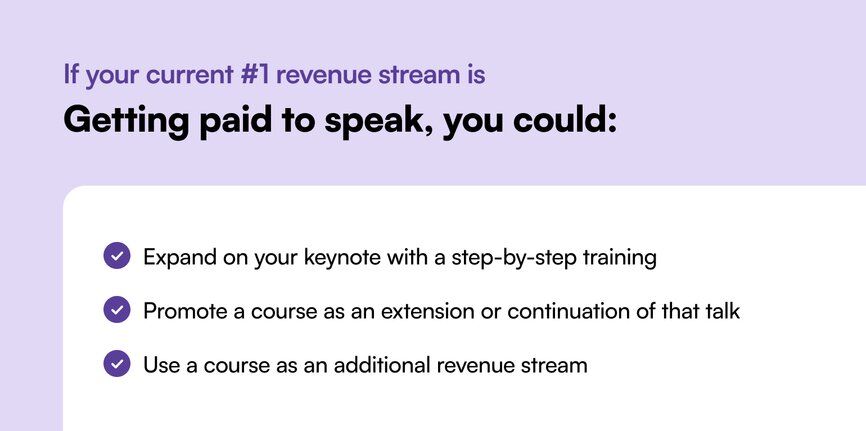
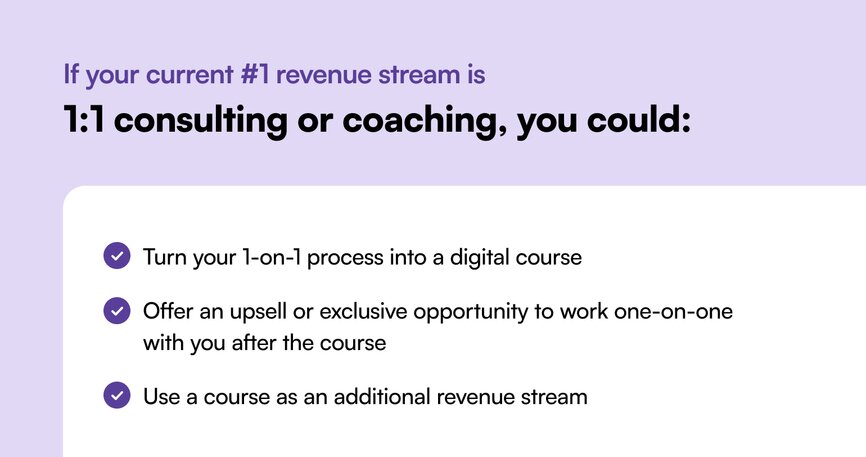

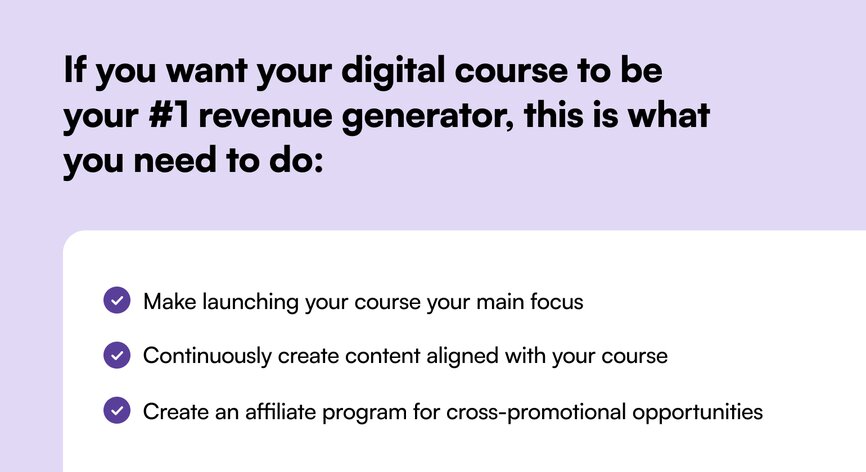
If you don’t fall into these buckets, it doesn’t mean you can’t still find success with courses. It might just take a little bit of extra work to get the results you’re looking for.
The playbook
“You never want to chase the money. You want to make sure you’re putting yourself out there, serving your audience, showing up for the right reasons, and the money will come.” - Amy Porterfield
Find your course creation sweet spot
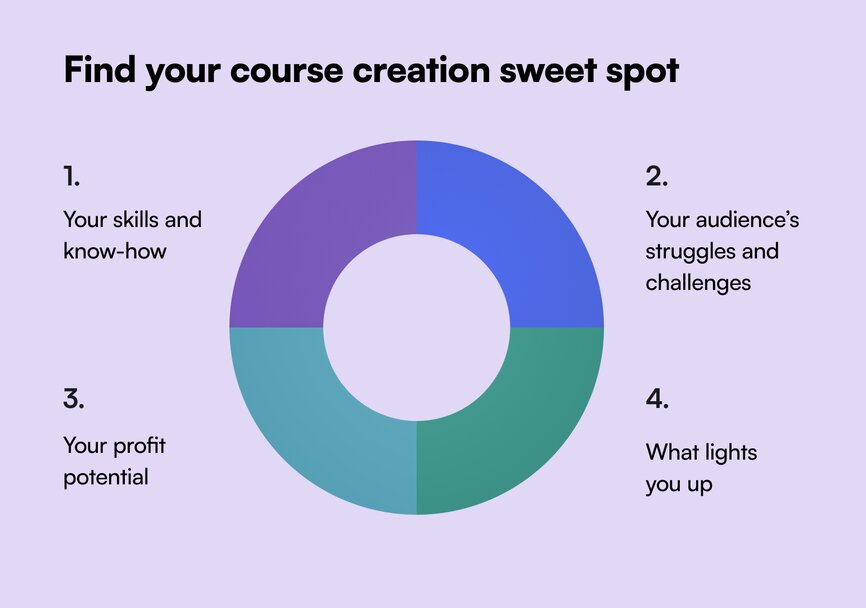
Creating a course can be intimidating for many reasons—but it becomes infinitely easier once you find your sweet spot, which combines the following four things:
- Your skills and know-how: Where have you gotten results for yourself or for somebody else that you could teach inside a course?
- Your audience’s struggles and challenges: Who is the person who’s struggling with a very specific problem or has a desire to get some kind of results? “Because once you have the knowledge and skillset, you want to pair it with the right audience who has a challenge or desire that you can meet with your expertise,” says Amy.
- Your profit potential: Before you create a course, ask yourself—are other people making money in the area that I want to create a course in? Do they coach or consult around this topic? Are there podcasts around this? If the answer is yes, that's a good thing—because it means people actually HAVE this problem.
- What lights you up: Does the idea of this course light you up? Because you’re going to launch it over and over again, you have to be excited by it.
3 ways to teach what you know
Amy talks a lot about helping people short-cut their way to success by teaching from your own expertise.
“Who cares about what I’ve gone through?” you might be thinking.
But the truth is, lived experience can be incredibly powerful in terms of providing insight to people who are just a few steps behind you, who are hitting the same barriers and asking the same questions you asked only a few short months or years ago on your journey.
So here’s three ways your story can help people on their path:
1. Teach your personal success path (the easiest option!) If you’ve gotten results for yourself in any area of your life, you can teach how you did it in your course.
2. Teach the 1:1 approach you’ve used with your clients. Whether you know it or not: you have a framework, or a certain model you follow when you work. Take that and build it out into a course.
Most importantly? Don’t let fear take the wheel: think abundance, instead. Amy loves to remind her students that “the people who buy a course to learn what you’re doing are not the same type of people who would hire you to do it for them.”
3. Teach a technique, tool, or process you’ve used to get results or enhance your own experience. An example: One of Amy’s students was an interior designer who mastered an interior design software (makes sense). She then created a course around how she optimizes and tweaks it as a master user! Another student earns millions teaching Excel—a program he doesn’t own, but can still profit from based on his expertise.
3 types of courses to create
In the online world, while there’s no clear-cut pricing guides or indexes that businesses have to adhere to, there are some basic guidelines.
For beginners in the digital course space, it makes sense to pick an achievable “size” of a course to start with, and expand further once you’ve proven success with your first.
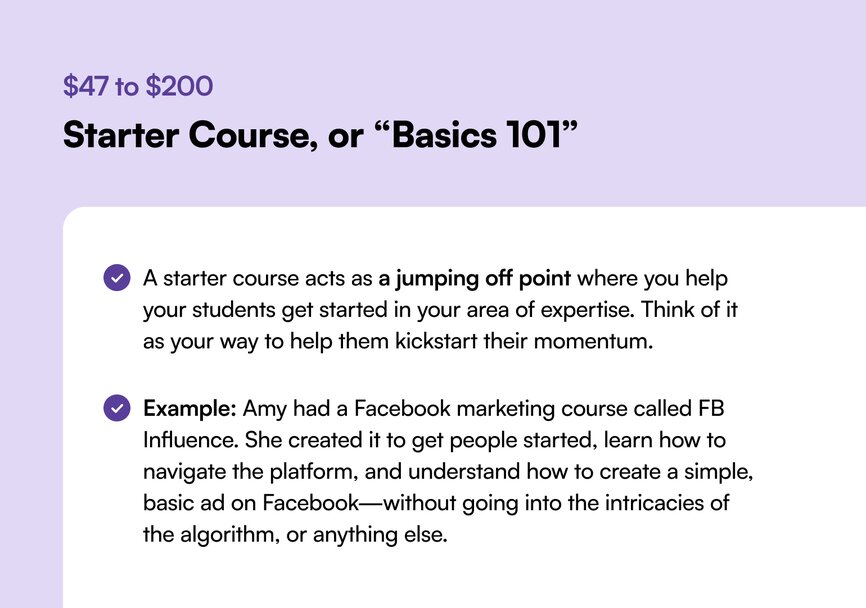
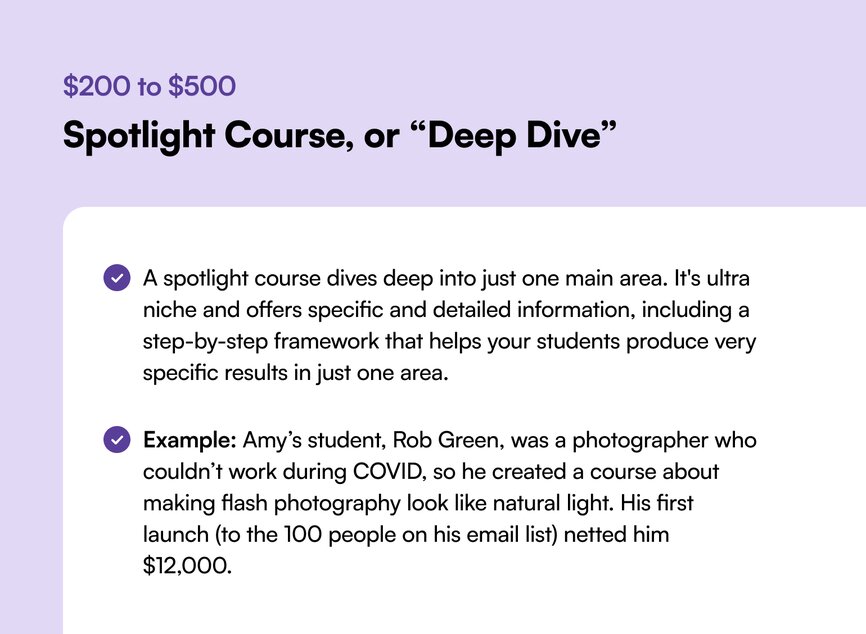

How to scale your course from starter to signature
Topic: Helping your infant/toddler have better sleep habits as a sleep consultant
Starter: Healthy sleep habits for your newborn, a getting started guide for all new parents
Spotlight: How to ensure your baby naps: the ins-and-outs of napping in the first year
Signature: Everything you need to know about helping your baby to sleep: the A-Z guide from newborn to 24 months
The results
At the end of 2023, Amy’s company hit $100M in revenue.
The majority of it came from her own digital courses. There’s one evergreen course that she “launches” every day, there’s the Digital Course Academy that she launches every September, and finally, there’s a membership she offers once the community from that course closes at the end of the 9 weeks.
Her undisputed secret to success? “Keep it really simple,” because “the bigger the results, the more you can charge.”
Which is why the success of her students has also become part of her calling card and marketing tactics: because the things she teaches help others get real results. Here’s some examples.
Success story: New Sound
Hadar runs a course called New Sound, which helps non-native speakers of English speak English with clarity, confidence, and freedom.
She’s earned over $4 million with Amy’s launch models:
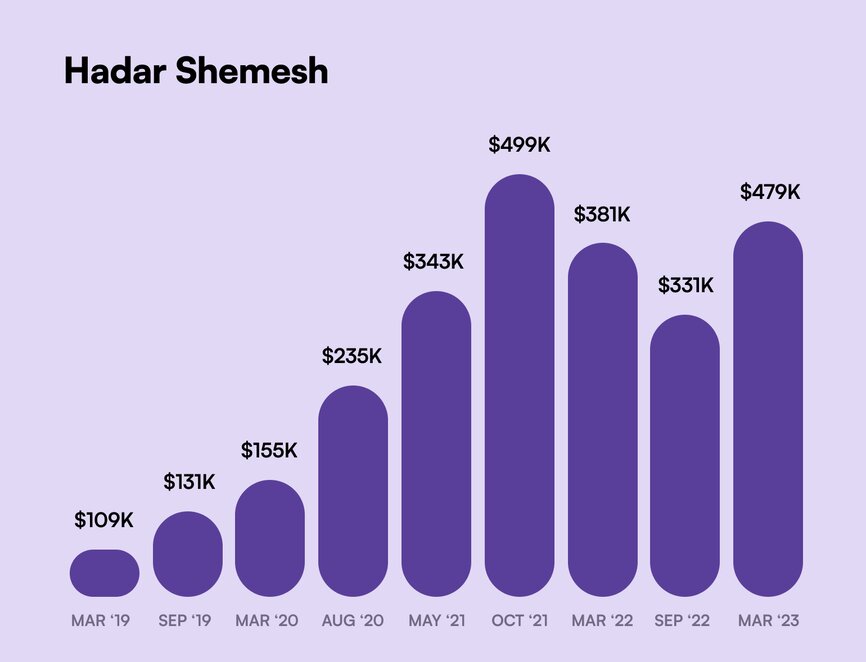
Success story: The Marketing School for Makers
Another one of Amy’s students, Lucy, is an artist and a coach who runs The Marketing School for Makers. She teaches artists and handmade sellers the “business stuff” of starting a business (picking a name, taxes and financials, pricing products, etc.)
Lucy earned almost $300,000 launching with Amy’s methods.
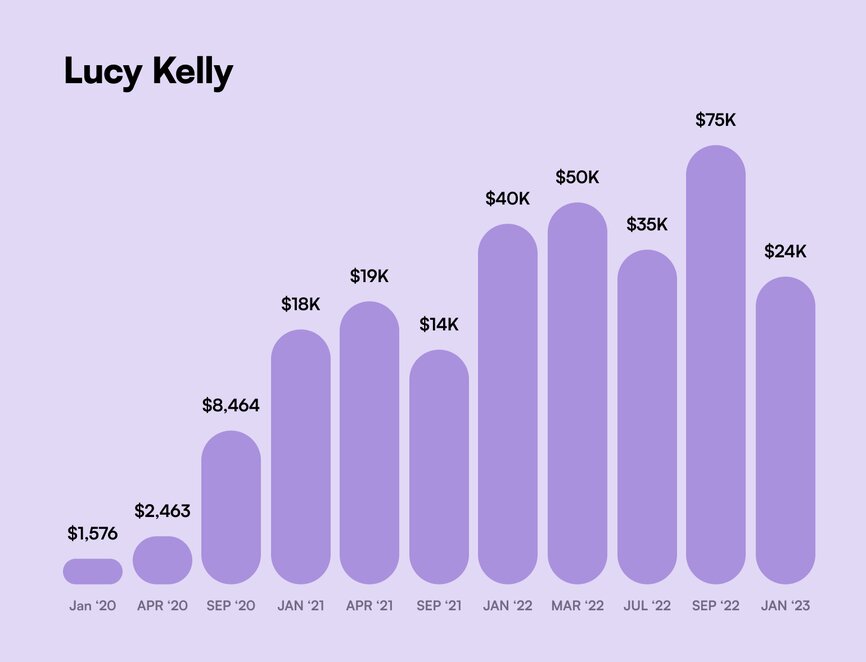
“The reason I share this with you is to remind you, once you commit to launching a course over and over again, it adds up. But if you keep changing ideas, you never get good at anything.” - Amy Porterfield
Amy’s learnings:
Courses introduce people to how you think and work—without the price tag of working with you 1:1. They’re an affordable way to access you for those who aren’t ready to work with you yet—and a way for people to get to know, like, and trust you over time. Plus, they let you increase your 1:1 prices.
You can “take more clients” by creating digital courses. “You will always hit a ceiling with one-on-one coaching or consulting,” says Amy, “Because there’s only one of you, and only so many hours in a day.” Courses give you a way out of the project- and client-work hamster wheel by allowing you to help more people in different ways and at different levels.
Avoid the top 3 course creator mistakes:
Promoting your course without a selling vehicle. Sharing the course on social media a few times and not getting any sales doesn’t mean it’s not working. You need a vehicle: a webinar, video series, bootcamp, or challenge that leads into selling. Emails and social media alone will not make you great money with your course.
Not knowing where your course fits into your business will take away your momentum. Is your course a way to work with you who can’t afford your 1:1 time? Is it a prerequisite for working with you 1:1 to make sure they’re bought in and committed? You have to get crystal clear on where a course sits in your offer funnel.
Launching your course once and moving on. “My first time launching a course, I made $267 and cried for a week,” says Amy. “The secret to entrepreneurial success is being in it for the long game.“ Every time you live-launch a course, you’re going to get better at your message, at doing webinars, at talking about the value you bring.
Running both live and evergreen course launches can keep you sane as an entrepreneur. Amy’s business model—where a course is automatically promoted and sold in the background, as well as launched live at certain points through the year—is the best of both worlds. “It won’t run you into the ground, offers longevity, scales well, and gives you multiple streams of revenue. Most importantly, it offers you flexibility as an entrepreneur—which is what we’re all after, isn’t it?”
Key takeaways
Stay horizontal longer—because staying in your lane allows you to become known for your niche. New entrepreneurs are very excited… and scatterbrained—but getting distracted by a million shiny ideas is bad for business. When you stay “horizontal”, and double down on one course and one topic, you become KNOWN for that topic in rooms where people ask those questions.
Don’t underestimate the power of a live launch. A lot of people want to create a course and instantly go to evergreen—because of the passive income dream. But the live launch experience, where your audience will tell you what works and what doesn't helps you tweak your messaging and makes you a better marketer.
Courses benefit from communities because:
They reduce refunds. For Amy, it goes as low as 2% refunds.
They help students get unstuck and get to the finish line.
They allow you to move your students into the next phase with you. Nobody says you have to keep a community for your course open indefinitely. Amy closes hers after the 9 weeks of the course, and upsells them into her membership.
And if you’re a creator, coach, educator, or entrepreneur looking for an all-in-one community platform?
You’re in the right place.
Circle brings together your members, discussions, events, courses, and content—all in one place, under your own brand. Plus, you get access to our customer community full of handy resources and over 10,000 community builders on the same journey as you.